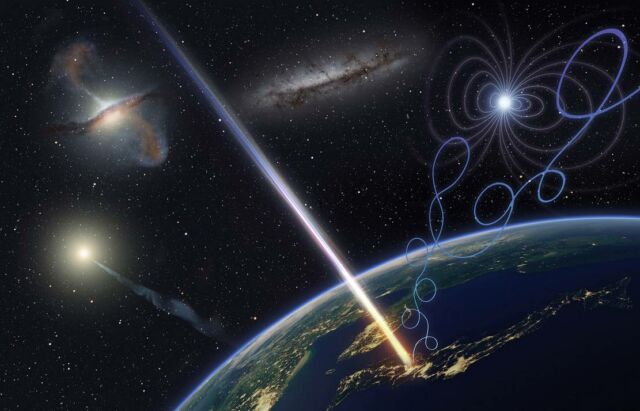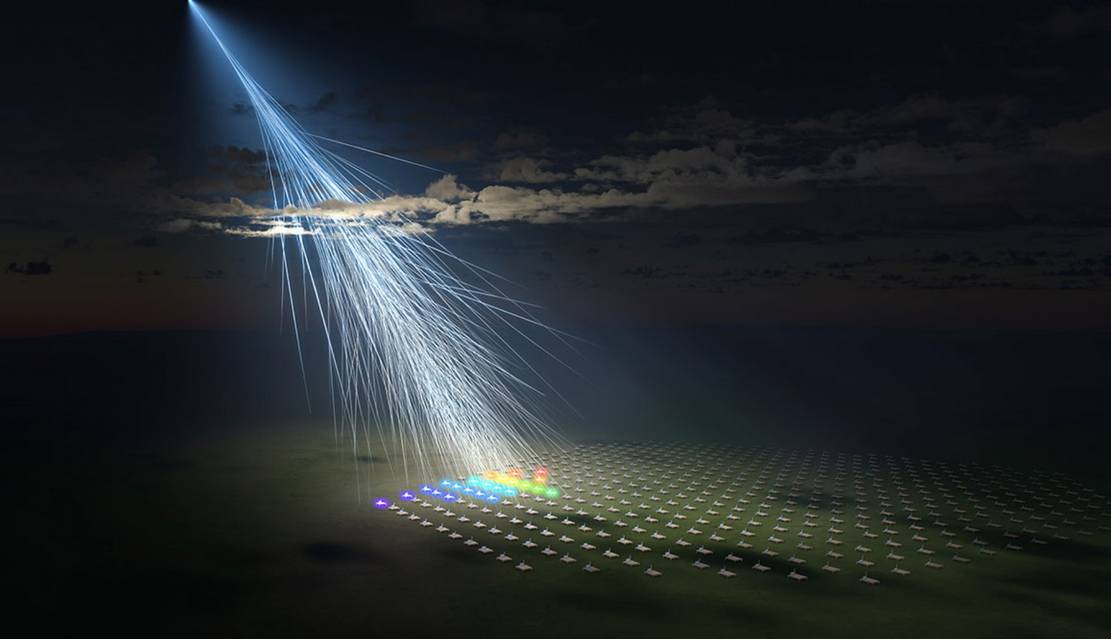A powerful cosmic ray hit Earth. Telescope Array detects the second highest-energy cosmic ray ever.
The international collaboration of researchers known as the Telescope Array in their study, published on November 23, 2023, in the journal Science, analyses the realm of ultra-high-energy cosmic rays, detailing the distinctive features of the particles, suggesting that these rare phenomena might be governed by particles that remain unknown to current scientific understanding.
Above: Artist’s illustration of the extremely energetic cosmic ray named “Amaterasu particle.” Credit Osaka Metropolitan University/L-INSIGHT, Kyoto University/Ryuunosuke Takeshige
John Matthews, Telescope Array co-spokesperson at the U and co-author of the study, said:
“The particles are so high energy, they shouldn’t be affected by galactic and extra-galactic magnetic fields. You should be able to point to where they come from in the sky. But in the case of the Oh-My-God particle and this new particle, you trace its trajectory to its source and there’s nothing high energy enough to have produced it. That’s the mystery of this—what the heck is going on?”
In 1991, the University of Utah’s Fly’s Eye experiment made a groundbreaking discovery by detecting the most powerful cosmic ray ever recorded. This particular particle, later named the Oh-My-God particle, stunned astrophysicists due to its extraordinary energy levels.
The Telescope Array has identified over 30 ultra-high-energy cosmic rays, although none have reached the astonishing energy levels of the Oh-My-God particle. The mystery deepens as the origin of these cosmic rays and the mechanisms enabling their journey to Earth remain elusive, with no observations shedding light on these enigmatic phenomena.
On May 27, 2021, the Telescope Array experiment made a significant observation, detecting the second-highest extreme-energy cosmic ray on record, with an energy level of 2.4 x 10^20eV. The event activated 23 detectors in the northwest region of the Telescope Array. Intriguingly, its trajectory suggested an origin from the Local Void, an expansive void adjacent to the Milky Way galaxy.
 Artist’s illustration of ultra-high-energy cosmic ray clarifies extremely energetic phenomena. Credit Osaka Metropolitan University/Kyoto University/Ryuunosuke Takeshige
Artist’s illustration of ultra-high-energy cosmic ray clarifies extremely energetic phenomena. Credit Osaka Metropolitan University/Kyoto University/Ryuunosuke Takeshige
The researchers have named this mysterious new particle the Amaterasu, drawing inspiration from the sun goddess in Japanese mythology.
The Oh-My-God and Amaterasu particles were identified through distinct observation techniques, underscoring the authenticity of these rare, ultra-high-energy events.
John Belz, a professor at the University (the U) and co-author of the study, explained:
“These events appear to originate from entirely different celestial locations. There isn’t a single enigmatic source. It could be anomalies in the fabric of spacetime, perhaps colliding cosmic strings. I’m throwing out speculative ideas, but that’s the reality when conventional explanations fall short.”
Cosmic rays are remnants of tumultuous cosmic events that have stripped matter down to its subatomic core, propelling it through the universe at nearly the speed of light. Essentially, cosmic rays encompass charged particles with diverse energies, including positive protons, negative electrons, or entire atomic nuclei, traversing space and incessantly showering down onto Earth.
source University of Utah



